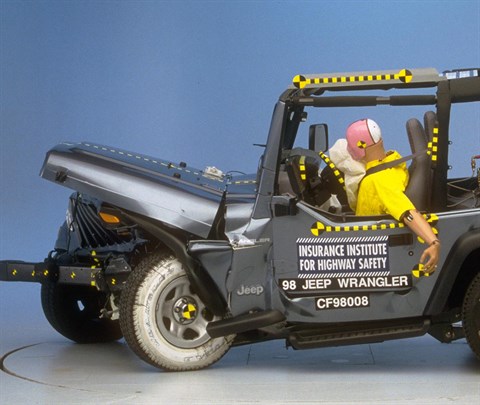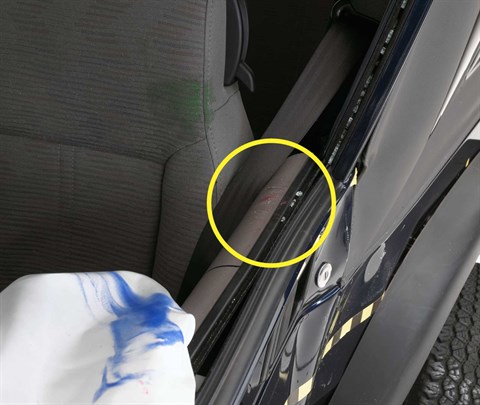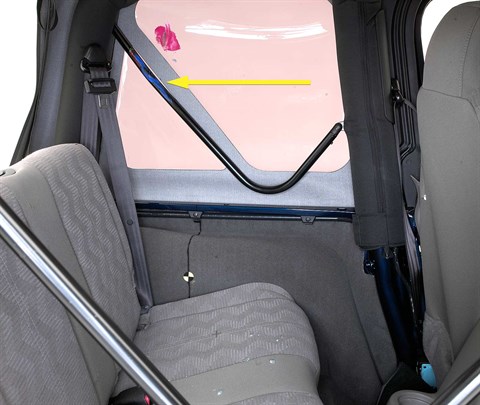Moderate overlap front: original test
Rating applies to 1997-2006 models
Tested vehicle: 1998 Jeep Wrangler SE 2-door 4wd
The Jeep Wrangler was redesigned for the 1997 model year. As in previous model years, it was available only as a 2-door (the 4-door model was not introduced until the next redesign, in the 2007 model year).
| Evaluation criteria | Rating |
|---|---|
| Overall evaluation | |
| Structure and safety cage | |
| Driver injury measures | |
| Head/neck | |
| Chest | |
| Leg/foot, left | |
| Leg/foot, right | |
| Driver restraints and dummy kinematics Dummy movement was reasonably well controlled. After the dummy moved forward into the airbag, it leaned toward the driver door. Its head and left shoulder moved outside the door because the doors on the soft-top model tested aren't high enough for optimal restraint. | |

Action shot taken during the frontal offset crash test.

The dummy's head and left shoulder leaned out of the vehicle after rebounding from the airbag. The problem is the driver door, which is too low to restrain the dummy optimally.

The driver space was maintained reasonably well, with only moderate intrusion into the footwell area.

Red paint on the knee bolster indicates where the dummy's left knee hit, producing moderately high forces on the femur.
Side: original test
Rating applies to 1997-2006 models
Tested vehicle: 2003 Jeep Wrangler X 2-door 4wd without side airbags (not available)
The Jeep Wrangler was redesigned for the 1997 model year. As in previous model years, it was available only as a 2-door (the 4-door model was not introduced until the next redesign, in the 2007 model year).
| Evaluation criteria | Rating |
|---|---|
| Overall evaluation | |
| Structure and safety cage | |
| Driver injury measures | |
| Head/neck | |
| Torso | |
| Pelvis/leg | |
| Driver head protection The dummy's head was hit by the window sill of the driver door. This impact did not produce high head injury measures, but the head protection is inadequate. | |
| Rear passenger injury measures | |
| Head/neck | |
| Torso | |
| Pelvis/leg | |
| Rear passenger head protection The dummy's head was hit by the by the diagonal steel tube supporting the convertible top. This impact did not produce high head injury measures, but the head protection is inadequate. | |

View of the vehicle and barrier just after the crash test.

View of the vehicle after the crash with door removed, showing damage to the occupant compartment.

Smeared greasepaint and glass marks show where the driver dummy's head was hit by the window sill.

Smeared greasepaint shows where the rear passenger dummy's head was hit by the diagonal steel tube supporting the convertible top.
Head restraints & seats
Seat type: Base seats
| Overall evaluation | |
|---|---|
| Dynamic rating | |
| Seat/head restraint geometry |
Seat type: Reclining front seats
| Overall evaluation | |
|---|---|
| Dynamic rating | |
| Seat/head restraint geometry |
About the head restraint & seat test
Currently, IIHS tests apply only to front seats.
